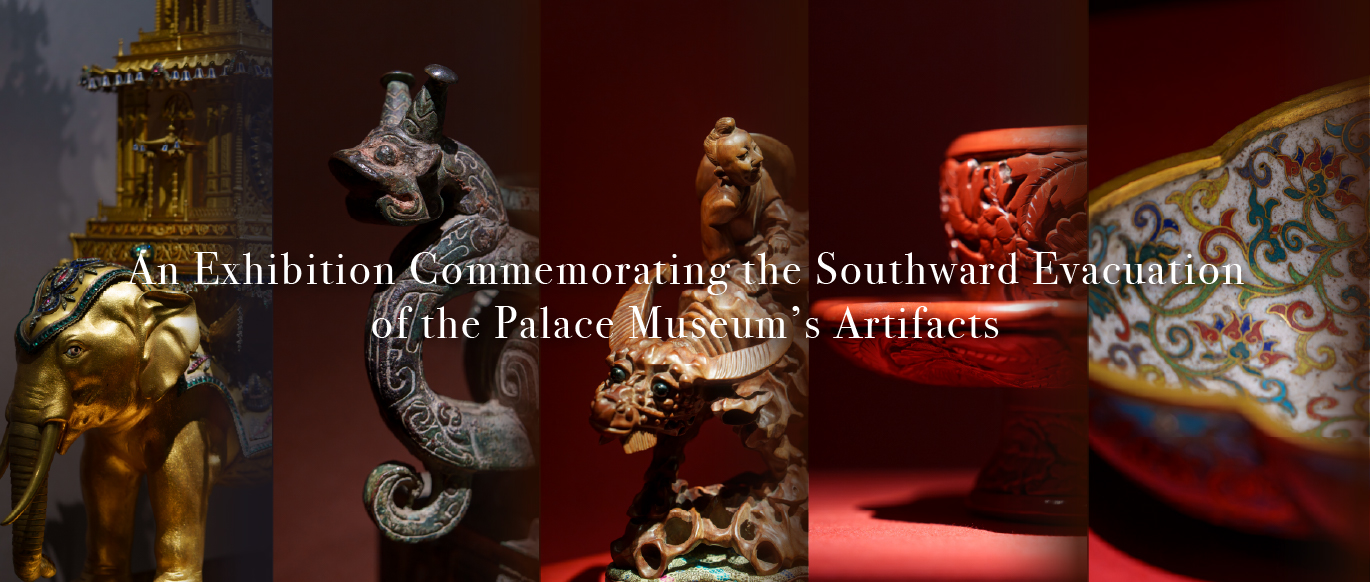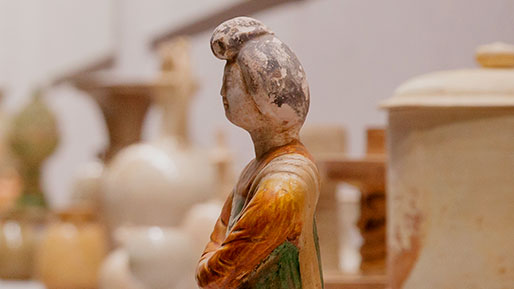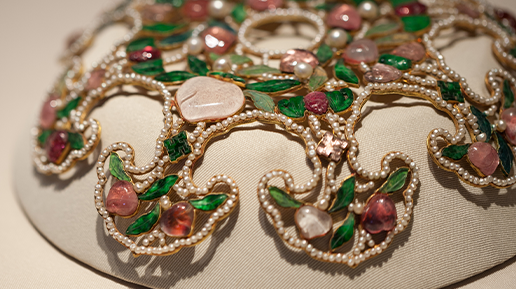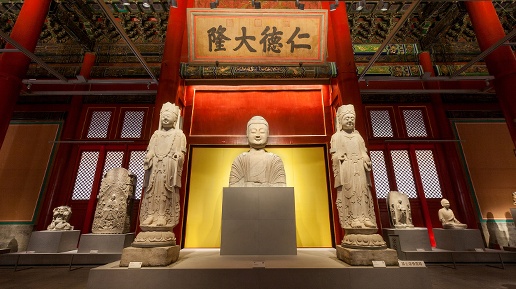
In 1925, Pope Pius XI (1857-1939) organized a major exhibition at the Vatican to showcase the beauty of cultures from across the globe, bringing together over 100,000 superb works of art, which aimed to demonstrate the Catholic Church’s high regard for the culture and artistry of all the peoples of the world.
Today we bring to the Palace Museum Chinese artifacts from the collection of the Vatican Museums. The Vatican collection includes a great variety of approximately 5,000 items from China, spanning the ages. Those shown here are divided into three sections:, Catholic Art, Buddhist Art and Secular Art. The Palace Museum, in a gesture of friendship and generosity, has furthermore added masterpieces of its own to be exhibited alongside works from the Vatican Museums.
The exhibits include gifts which bear witness to centuries of China-Vatican friendship as well as exquisite artifacts which integrate Catholic and Chinese arts. There is also a wonderful oil painting from the Vatican Museums—Adam and Eve in the Earthly Paradise. This painting expresses the desire for harmony between humankind and nature that heads of states of both countries have often spoken of.
As the name “Beauty Unites Us” indicates, we hope this journey into the beauty of the art of China and of the Vatican helps to unite us on the road towards a future of lasting friendship.
Catholic Art
With the spread of Catholicism in China came the Sinicization of Catholic art. Catholic works of art embodying Chinese aesthetics are thus a highlight of this exhibition, with famous stories of the Western world taking on an Eastern appearance. We have carefully picked oil paintings from the collection of the Vatican Museums which echo the Chinese paintings on display, showing the natural yet profound interaction between civilizations. In this section, the Palace Museum has added renowned works by the Catholic artist Wu Li (1632-1718) and equally famous works by Giuseppe Castiglione, a Jesuit from Milan who is known in China as Lang Shining (1688-1766). Wu, as a Catholic, broke through the bounds of literati painting by focusing on the sufferings of the common people in his works; Castiglione, as a missionary, combined Oriental and Occidental painting techniques perfectly, exerting tremendous influence on the art of the Qing court. Their works represent the unique charm of the Catholic art that developed in China.
You must be attracted by the big oil painting by Wenzel Peter in this section. The harmony shown in this painting demonstrates the world’s harmony and coexistence.
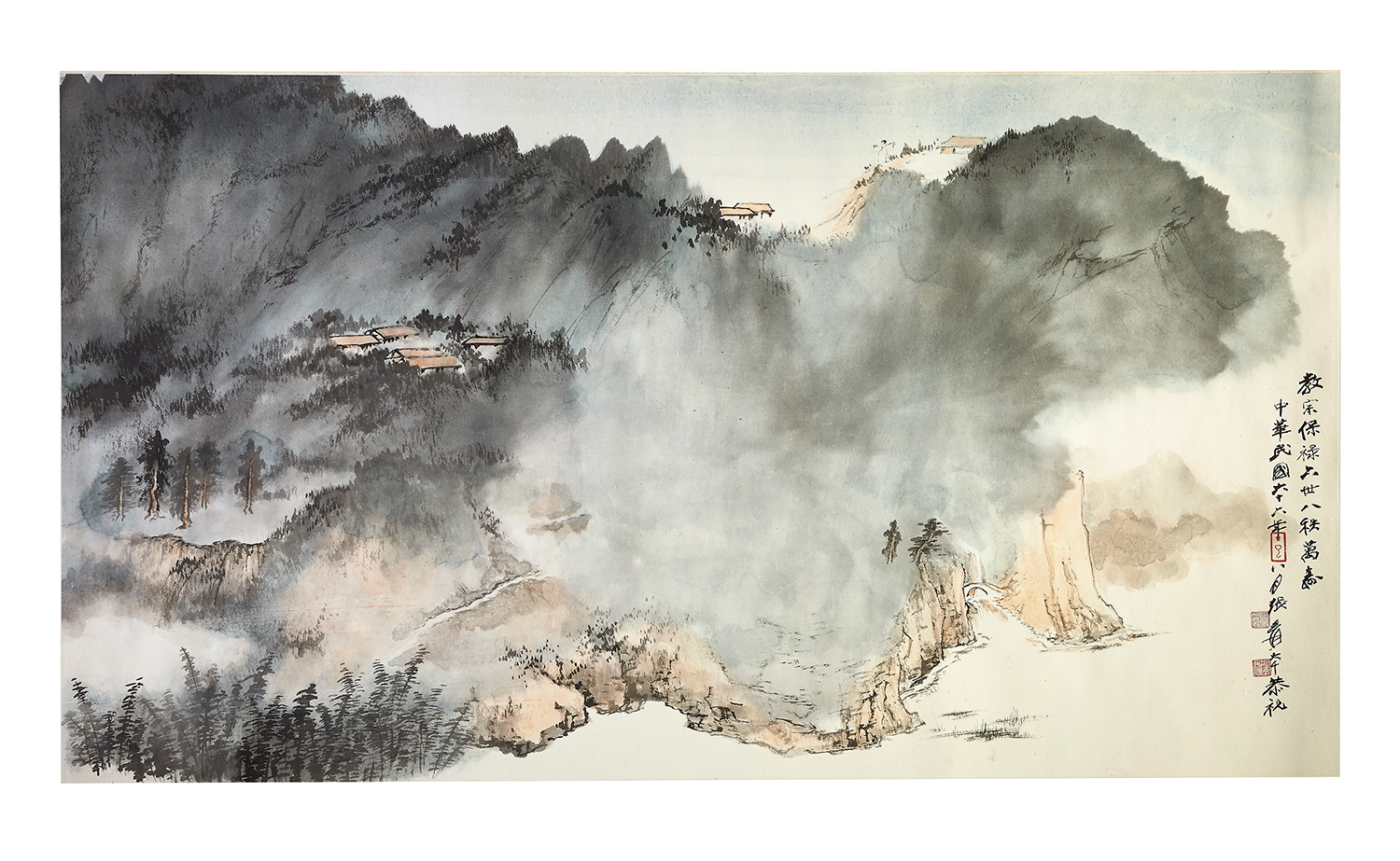
Landscape
1978
Ink and colour on paper
58.7 x 39.5 cm
inv. 126301
This landscape was painted in Rome by the master Huang Junbi (1898-1991) in 1978 and was dedicated to John Paul II. Its title is shan gao shui chang (One’s nobility lasts forever). Literally translated, the title means “high as a mountain and long as a river”, a Chinese expression indicating that one’s nobility (reputation or nobility of character) lasts forever. The structure of the painting follows all the rules for the temporal and spatial arrangement of the components of shanshui (Chinese landscape painting), doing so in order to provide a number of visual devices that draw the viewer into the scene and suggest the path to be taken when looking at it.
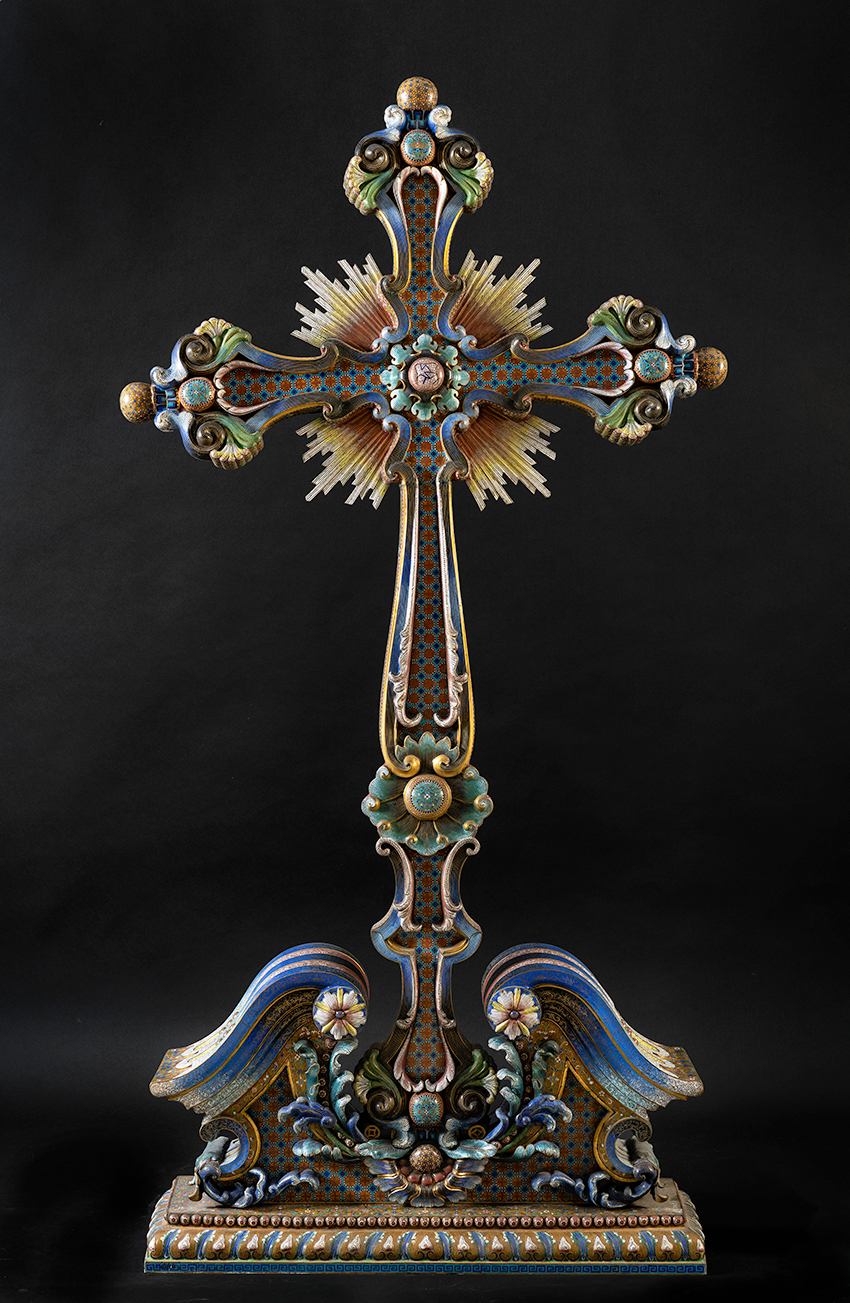
Cross
Early 20th century
Cloisonné
140 x 65 x 20 cm
Inv.119968
This cross is a faithful reproduction of the one in the Beijing Catholic Church, the North Church (The Church of the Saviour). Cloisonné is a craft familiar to the Chinese. It is commonly known as jingtailan where copper is used as the inner material.

Madonna and Child in a Typical Chinese Garden
Early 20th century
Ink and colour on paper
205 x 68 cm 205*77
Inv. 125461
In Catholic figurative art, there is a fondness for representations of Mary (often called “Madonna”—My Lady) and the child Jesus. One example is the painting on a hanging scroll from the early 20th century entitled Madonna and Child in a Typical Chinese Garden. Although subjects chosen by the artist are Catholic, his paintings could be included among the most classic examples of Chinese painting with regard to their setting, their composition, and their conception of the human figure. The Madonna, Jesus and the Angel have oriental features, are dressed in the Chinese style and are depicted in a garden in which there is a towering rock. The spatial composition and choice of component elements recall one of the masterpieces of Song Dynasty (960-1279) painting by Su Hanchen (act. 1130-1160). It is a unique reflection of Catholic religion in the context of Chinese culture.

The Flight into Egypt
Early 20th century
Ink and colour on silk
187 x 83 cm
Inv. 125558
The painting shows the Holy Family—Joseph, Mary and the infant Jesus—fleeing from Bethlehem to exile in Egypt. They were escaping Herod the Great, the Roman-appointed King of Judaea, who feared that Jesus would eventually cause his downfall. Therefore, the king wanted to have him killed.
In this exhibition, there is another oil painting with the same subject.
The inscription on the painting reads: 任懿芳 恭绘 (“Respectfully made by Ren Yifang.”) Red seal: 懿芳 (Yifang)
In the left upper corner, a seal with eight chinese characters 天主圣母,为我等祈 (“Holy Mother, pray for me”).
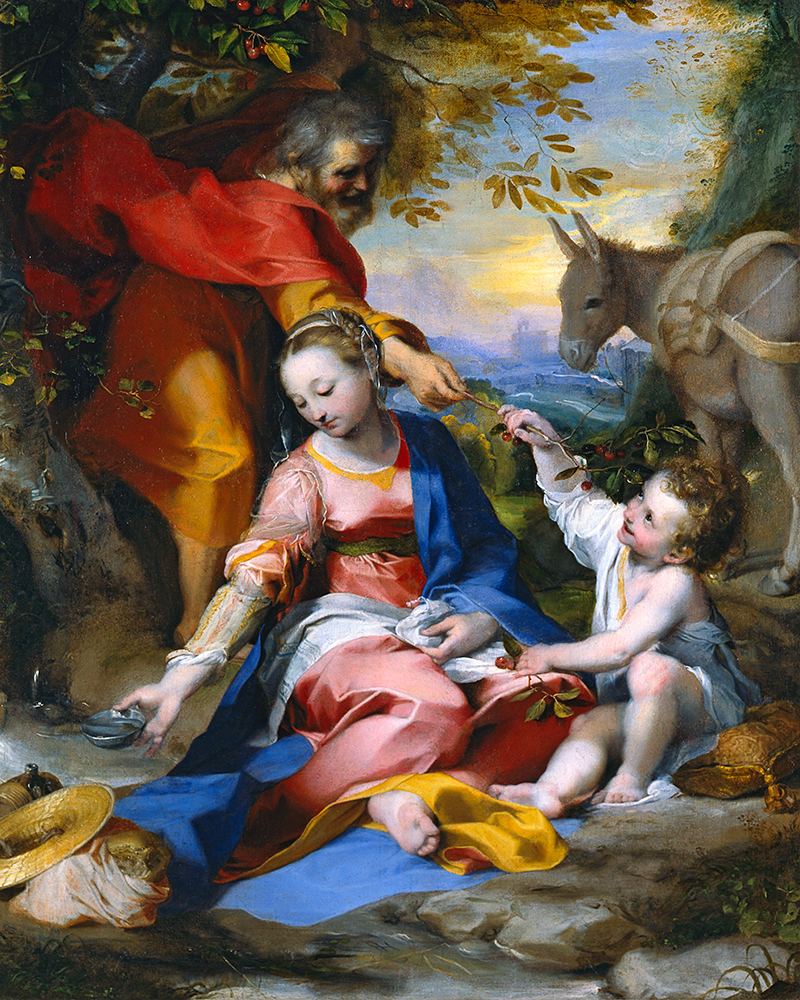
Rest on the Flight to Egypt
1570-1573
Oil on canvas
133 x 110 cm
inv. 40377
In this painting, Federico Fiori, also known as Barocci, depicts a theme dear to him, one that he repeated several times between 1570 and 1573, the Rest of the Holy Family (Mary, Joseph and the Child Jesus) on the flight to Egypt to escape the massacre of the children ordered by Herod.
The subject is taken from an apocryphal writing (the Gospel of Pseudo-Matthew), which recounts that the Virgin, the Child, and Joseph, exhausted by the hardship of their flight to Egypt, stopped to rest under a palm tree. The tree bowed down to offer its fruits and a stream flowed at their feet to quench their thirst.
In the Barocci painting, the palm is replaced by a cherry tree. Saint Joseph is shown bending a branch to offer the red fruit (an allusion to the sufferings of Christ) to the Child Jesus, who smiles as he accepts it, as if to indicate that he is also accepting his destiny. This subject is also favored by other artists. Also in this exhibition, there is another painting of the same subject but with figures in traditional Chinese costume.
Barocci, a painter from the city of Urbino (Italy), lived during the second half of the sixteenth century. He is renowned for the way he combines light and shadow, design and color to create images of unparalleled harmony, as can be seen in this wonderful painting.
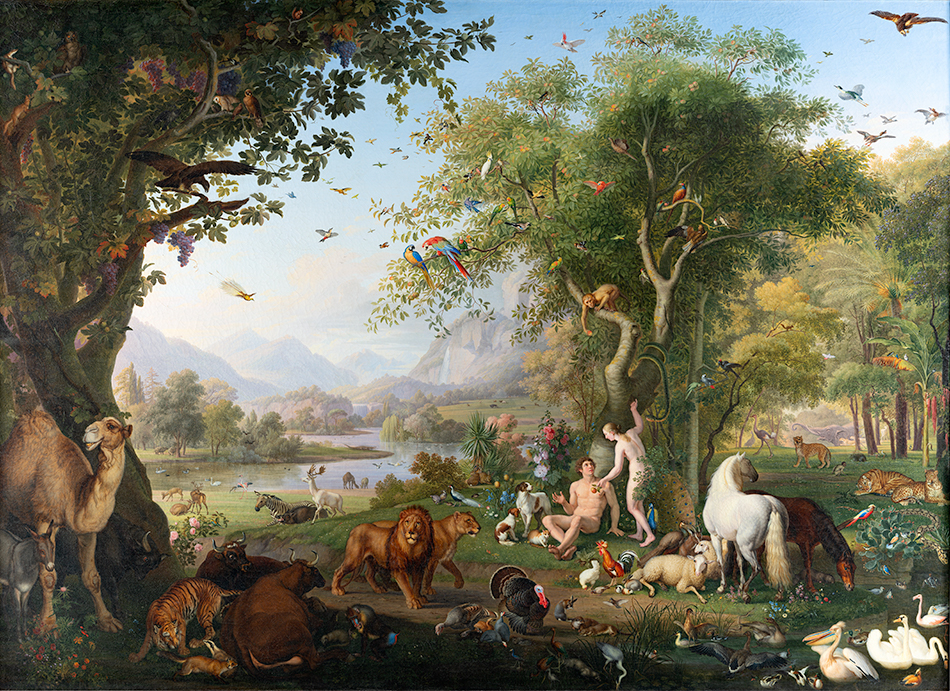
Adam and Eve in the Earthly Paradise
Wenzel Peter
End of the 18th century
Oil on canvas
247 x 336 cm
inv. 41266
Under a large tree, Eve, the first woman, offers the forbidden fruit, to Adam, the first man. The evil Serpent, who is coiled around tree trunk, had convinced her to disobey God’s command.
This act shatters the wonderful harmony of the Earthly Paradise, here depicted by the splendors of vegetation, water, and landscape, and by an incredible number of animals and birds.
The artist is the Bohemian-born painter Wenzel Peter, who in 1774 moved to Rome from Vienna, where he was an illustrator of books and engraver. It was in Rome, where he studied, that he painted this huge canvas, which he signed Wenceslaus Peter fecit Romae ( Wenceslas Peter made this in Rome).
The artist’s attention to naturalistic provides, as it were, an index of the encyclopedic culture of the period. Showing an extraordinary knowledge of botany and zoology, Peter depicts countless plants and more than 240 animals and birds from around the world.
Apart from its religious significance, this painting shows a harmony between human and nature, which expresses the main idea of this exhibition: great harmony between civilizations.
Buddhist Art
Though at the heart of the Catholic civilization, the Vatican is inclusive and open to other religions. Missionaries from across the world have brought back numerous works of art from other religions, offered as gifts, including many Buddhist artifacts from China. Works of art from the Vatican Museums in this section date back to different periods and derive from different schools and regions, such as Qing Tibetan Buddhist statues. To enrich this exhibition, the Palace Museum has also selected related Buddhist artifacts from its own collection.

Shakyamuni Buddha
Ming Dynasty (1368-1644)
Gilded and lacquered bronze
40 x 27 x 21 cm
Inv. 120523
Statue of the penitent Buddha Shakyamuni with both hands resting on his left knee. The Buddha has curly hair in pepper-corn style, which shows the ushnisha, a protuberance at the top of his head.
This kind of iconography goes back to the sculpture that developed in the Indian region of Gandhara between the 2th and the 3th centuries CE. This statue was made in China during the Ming period (1368-1644).
Secular Art
With the “China craze” since the seventeenth century, Chinese objects were in great demand in Europe and were much imitated, becoming integrated into everyday life. The artifacts were used to decorate halls and castles, creating unique surroundings. This fashion demonstrates the understanding and appreciation of another civilization for that of China. Besides the ancient Chinese artifacts collected by the Vatican Museums.
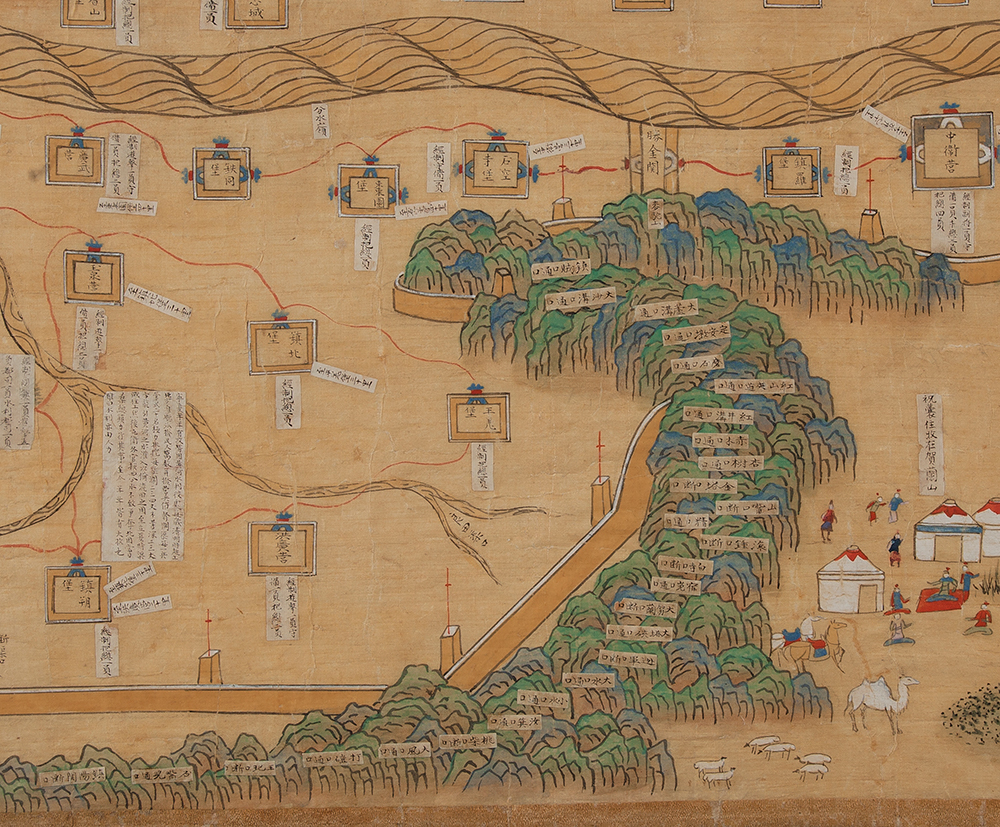
(Detail)
Handscroll: The Great Wall
Kangxi reign (1662-1722), Qing Dynasty
Ink and colour on silk
38 x 775 cm
inv. 114427
One of the most interesting objects in the collection of Cardinal Cesare Borgia (1731-1804) was a long, painted handscroll with a detailed map. The scroll, dating from the years between 1680 and 1700—during the Kangxi Emperor’s reign (1662-1722)—shows the Great Wall and the different territories that it crosses. The depictions and captions provide detailed knowledge of the area—its mountains, rivers, cities, wells, military camps and garrisons.
A peculiar feature of the scroll is that the north is at the bottom of the map, following an ancient Chinese practice.

Imperial Robe
Qianlong reign (1736-1795), Qing Dynasty
silk, cotton
142 x 230 cm
Inv. 111216
This is an imperial yellow silk garment from the 18th century. It features tight, long sleeves with a horse hoof cuff, called matixiu. The decoration follows the usual pattern: from the bottom upwards, there is a vertical water pattern, a lishui, which forms the spiraling waves, pingshui, of the Cosmic Ocean, out of which rises the cosmic Kunlun Mountain. The garment is decorated with the twelve traditional Chinese emblems of imperial authority and with traditional symbolic animals. At chest level and in the center, there is a five-clawed dragon depicted in the classic circular position that has the dragon chasing the flaming pearl, leizhu.
The imperial attire of the Qing includes a rich symbolic apparatus, which combines styles of northeast dress and iconography traditionally associated with the imperial power.
In 1759 the Emperor Qianlong (1736–1795) drew up a veritable corpus of laws with established and hierarchically organized models, genders, colors, decorations, accessories and insignia of rank, bringing order to practices that had become widespread, but were only partially enshrined in law. The main purpose of this legislation was to make the positions and functions of the different members of the imperial household immediately recognizable through their dress and accessories. There are also two dragons rising up from the waist, and dragon patterns are also decorated on the shoulders and back of the robe.





